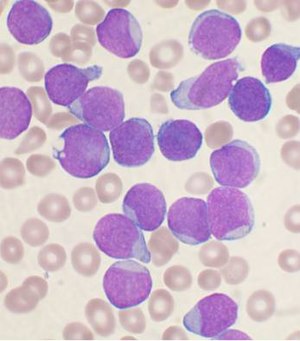Leukemia
| Leukemia | |
|---|---|
 |
|
| A Wright's stained bone marrow aspirate smear from a person with precursor B-cell acute lymphoblastic leukemia. | |
| Pronunciation | /luːˈkiːmiːə/ |
| Classification and external resources | |
| Specialty | Hematology and oncology |
| ICD-10 | C91-C95 |
| ICD-9-CM | 208.9 |
| ICD-O | 9800-9940 |
| DiseasesDB | 7431 |
| MedlinePlus | 001299 |
| eMedicine | article/1201870 |
| MeSH | D007938 |
Leukemia, also spelled leukaemia, is a group of cancers that usually begin in the bone marrow and result in high numbers of abnormal white blood cells. These white blood cells are not fully developed and are called blasts or leukemia cells. Symptoms may include bleeding and bruising problems, feeling tired, fever, and an increased risk of infections. These symptoms occur due to a lack of normal blood cells. Diagnosis is typically made by blood tests or bone marrow biopsy.
The exact cause of leukemia is unknown. Different kinds of leukemia are believed to have different causes. Both inherited and environmental (non-inherited) factors are believed to be involved. Risk factors include smoking, ionizing radiation, some chemicals (such as benzene), prior chemotherapy, and Down syndrome. People with a family history of leukemia are also at higher risk. There are four main types of leukemia — acute lymphoblastic leukemia (ALL), acute myeloid leukemia (AML), chronic lymphocytic leukemia (CLL) and chronic myeloid leukemia (CML) — as well as a number of less common types. Leukemias and lymphomas both belong to a broader group of tumors that affect the blood, bone marrow, and lymphoid system, known as tumors of the hematopoietic and lymphoid tissues.
...
Wikipedia
